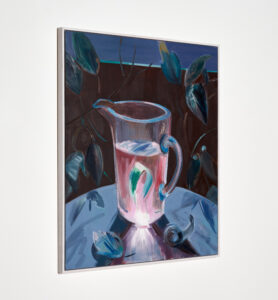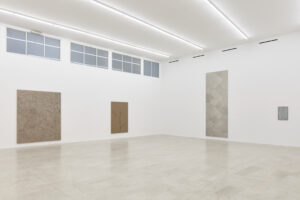Still life, pictorial protagonism of objects and illusionistic representation are categories, in the past widely frequented by the history of art, which today we tend to perceive as marginal with respect to the most widespread currents of research, tendentially compact in converging in the figurative field towards a sort of anthropomorphism dreamlike in which human features are a pretext for plumbing the depths of the individual or collective unconscious. If up to a certain point it seemed that Pop Art had saturated and exhausted the possibilities of presenting the object as a pure fact elevated to an icon, painting continued to wonder about the possible ways of restitution of the visible and on what meaning the different results of this attempt may have in relation to our concept of reality. A privileged field of investigation for such research could only still be that of objects, apparently neutral in their being inanimate and mass produced, but increasingly elusive and ambiguous, regardless of the style and technique with which each artist then decides to evoke them on the canvas as images.

Mairead O’hEocha, Light Spells Enter, 2023, installation view, P420, Bologna, photo Carlo Favero, courtesy P420, Bologna
Two exemplary studies regarding the diversity of outcomes to which this reflection can give rise are those of the Irish painter Mairead O’hEocha (1962, Dublin, IR) and the German Helene Appel (1976, Karlsruhe, DE), to whom the P420 gallery of Bologna simultaneously dedicates two personal exhibitions entitled, respectively, Light Spells Enter and On the Cutting Board. The first is characterized by a compendium painting in which the subjects are modeled by decisive brushstrokes which, while openly declaring themselves as such, spontaneously fulfill both the structural function of the drawing and the visual modeling of the surfaces. In the second, on the other hand, what is always left visible to betray the illusionistic convention underlying the pictorial representation is the rough background canvas, on which the images instead seem to recreate the essence of the represented subjects through an extreme reduction of the material traces of the pictorial medium.

Mairead O’hEocha, Father visit, June, 2022, oil on board, 80 x 65 cm, photo Carlo Favero, courtesy P420, Bologna
The two artists, almost poles apart in terms of aesthetics and approach to the practical dimension of making, share a passionate sensitivity in entering into a relationship with the mysterious poetic nooks and crannies of common objects and a similar propensity to restore their enigma through a figuration that one would be tempted to classify as an extreme offshoot of the Magical Realism current. In Helene Appel this intent is expressed in a terse and meticulous rendering of ostentatiously residual fragments of reality which, reproduced on a 1:1 scale, take on an almost sacred value. In Mairead O’hEocha, on the other hand, the same attitude leads to the theatricalization of domestic glimpses in which the arrangement of objects sketches fleeting narrative hypotheses, to which the autobiographically cryptic titles of the works also allude. In both cases, the alienating effect is given by the fact that the objects depicted, in addition to being perfectly attributable to what surrounds us on a daily basis, seem animated by an inner energy that makes them have their own life (whether one considers them as belonging to the fictitious habitat of representation and whether one looks at them as pure pieces of painting).

Mairead O’hEocha, September Salt Crab with Fruit Bowl, 2021 (detail), oil on board, 80 x 68 cm, photo Carlo Favero, courtesy P420, Bologna
The first room of the gallery is dedicated to Mairead O’hEocha, who presents here a series of paintings made between 2020 and 2022 during the pandemic period, in which for the artist, as for all of us, the domestic environment and images conveyed by digital devices have temporarily become the only accessible visual horizon. Each composition is centered on a large transparent container positioned on a table and framed by ordinary elements that act as a scenic backdrop (such as curtains, ajar door wings or leafy plants), around which other smaller objects gravitate in scenographic disorder. At first glance, nothing anomalous, but the sulphurous light that pervades these nocturnal settings immediately alerts us, instigating us to wonder what the origin of the ambiguity we perceive is. The artist explains that the almost sinister glow that we see spreading from a logically unjustified source (which in many cases seems to be positioned right inside the transparent containers) reproduces the backlighting of digital screens, a choice that projects the vision into an unspecified interregnum, liminal between here and elsewhere.

Helene Appel, On the Cutting Board, 2023, installation view, P420, Bologna, photo Carlo Favero, courtesy the artist and P420, Bologna
The artificial and mental connotation of light does not prevent the artist from experimenting with one of the most virtuosic challenge of the still life genre, i.e. the reproduction on the canvas of the reflections of the mirroring surfaces and of the different gradations of transparency to which the thickness, curvature and chemical composition of the glass can give rise. This search for truthfulness blends without conflict with a purely imaginative intention in interpreting the surface texture of other objects, which sometimes reaches the intentional emphasis of ambivalences that undermine the supposed uniqueness of the referent. As an example we cite in this regard, as the critical text by Ben Eastham points out, the case of the curtain that appears in the background of Noble Sister Widow, October (2022), in which the brushstrokes evoke both the vertical folds of a fabric and the locks of a combed hair. A further destabilizing factor that unites all the paintings is the presence, in each of them, of small living creatures (a goldfish in a bowl, a spider, a fly, a grasshopper, etc.) that move in the staging, to which our gaze is never able to assign a precise gradient of reality.

Helene Appel, Sandbox, 2023, acrylic on linen, 230 x 190 cm, courtesy the artist and P420, Bologna
In the second room of the gallery, the register changes completely with the rarefied painting by Helene Appel, who punctuates the space of the walls with a sequence of canvases of different sizes, each of which is dedicated to a specific object, reproduced in full size with a hyper-realistic style. The artist establishes a deep relationship with the most ordinary and banal aspects of everyday life, celebrating the absolute value of contemplation and conservation in the era of impermanence. Her privileged subjects are the residues of human habits or fragments of anthropized nature, which are transfigured by the sublimation of their most prosaic aspect. Rags, tiles, chopped vegetables, sink drains, tablecloth shaking, but also sand, dry branches, rice grains or liquids spilled on a surface are painted in detail on unprimed canvases, whose measurements support and surround the encumbrance of real objects. Every look that the artist dedicates to her model translates into an exact and measured brushstroke that reveals a specific sensitive quality and that requires the observer an equally dilated investigation time to compare its adherence with the corresponding mental archetype of reference.

Helene Appel, Loose Red Fabric, 2023, watercolour on hessian, 291,5 x 245 cm, courtesy the artist and P420, Bologna
Appel dissects with impeccable analytical lucidity the circumscribed portions of the visible on which she decides to concentrate, to then restore their pictorial analogy by fielding a large arsenal of artifices elaborated by centuries of trompe l’œil painting. But, just when the fictitious nature of these solemn deposits of visible contingencies seems to take over and the temptation to approach the painting and touch it to ascertain the real consistency of what we see depicted becomes irresistible, the rough texture of the canvas emerges as an inescapable presupposition of the painted object, which is thus brought back to the limbo of images. In the raw dialectic coexistence between presentation and representation, the veil of illusion is torn at the moment of its maximum exaltation, revealing the sophisticated conceptual matrix of the artist’s work. If the rough texture of the canvas seems to compete with the fictions it hosts, while in turn the figures seem to want to blend into the warp by adding further abstract patterns to its regular weave of threads, it is the painting itself as a whole that shows itself as an object and as a device of consciousness capable of investigating the structure of the visible. In this way the act of painting is analyzed and broken down into its constituent elements and it takes place in the unsolvable tension between the faithful reproduction and the incessant possibilities of transformation of a material that becomes an image.
Info:
Mairead O’hEocha. Light Spells Enter
Helene Appel. On the Cutting Board
25/02/2023 – 29/04/2023
P420
Via Azzo Gardino, 9 Bologna
www.p420.it
Graduated in art history at DAMS in Bologna, city where she continued to live and work, she specialized in Siena with Enrico Crispolti. Curious and attentive to the becoming of the contemporary, she believes in the power of art to make life more interesting and she loves to explore its latest trends through dialogue with artists, curators and gallery owners. She considers writing a form of reasoning and analysis that reconstructs the connection between the artist’s creative path and the surrounding context.






NO COMMENT